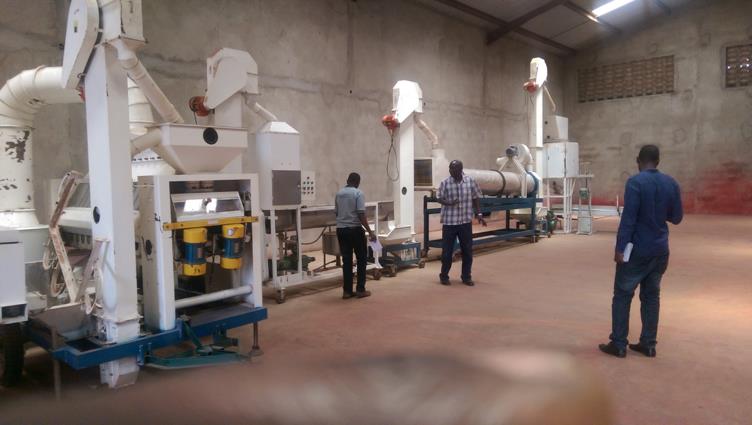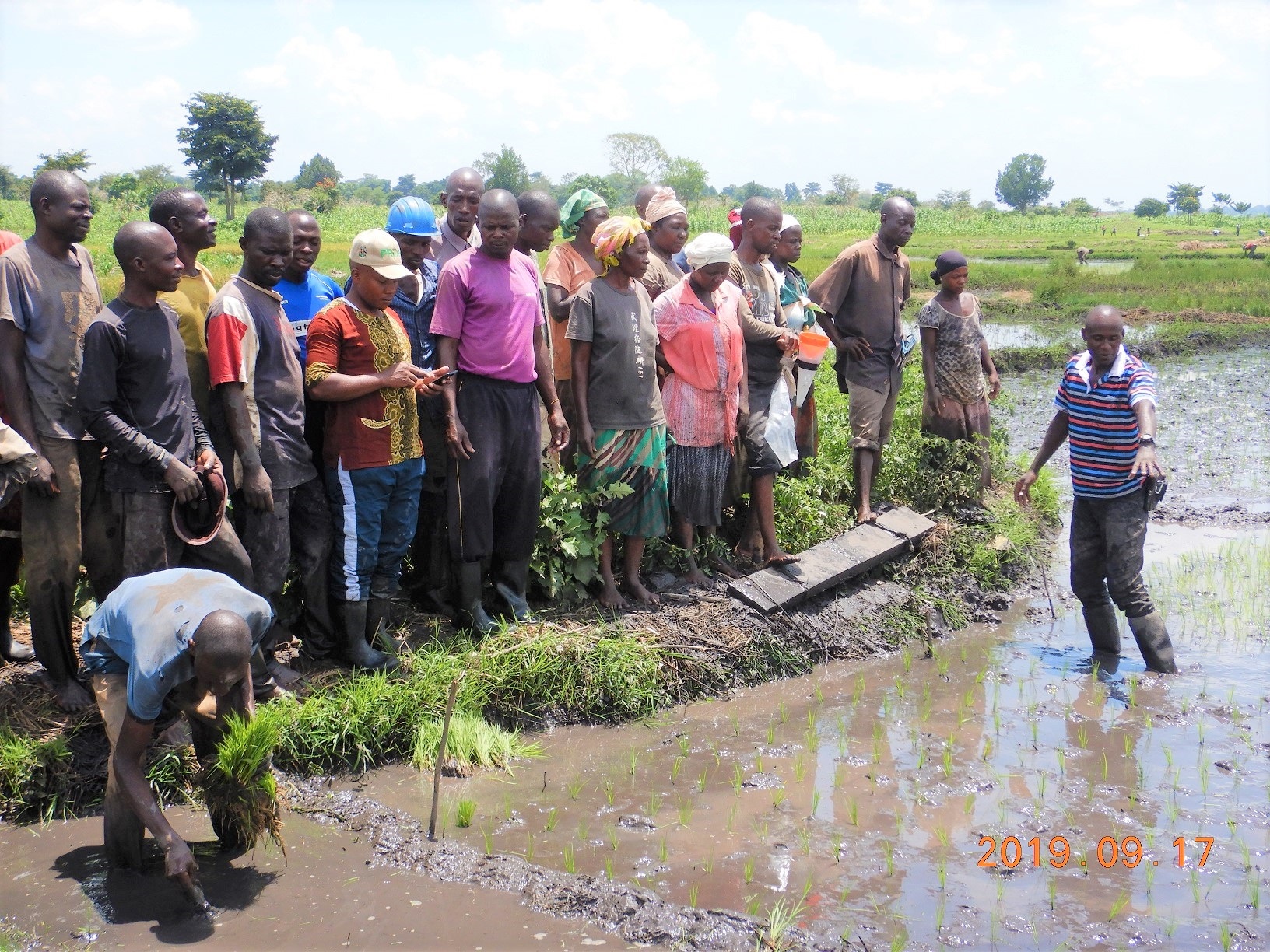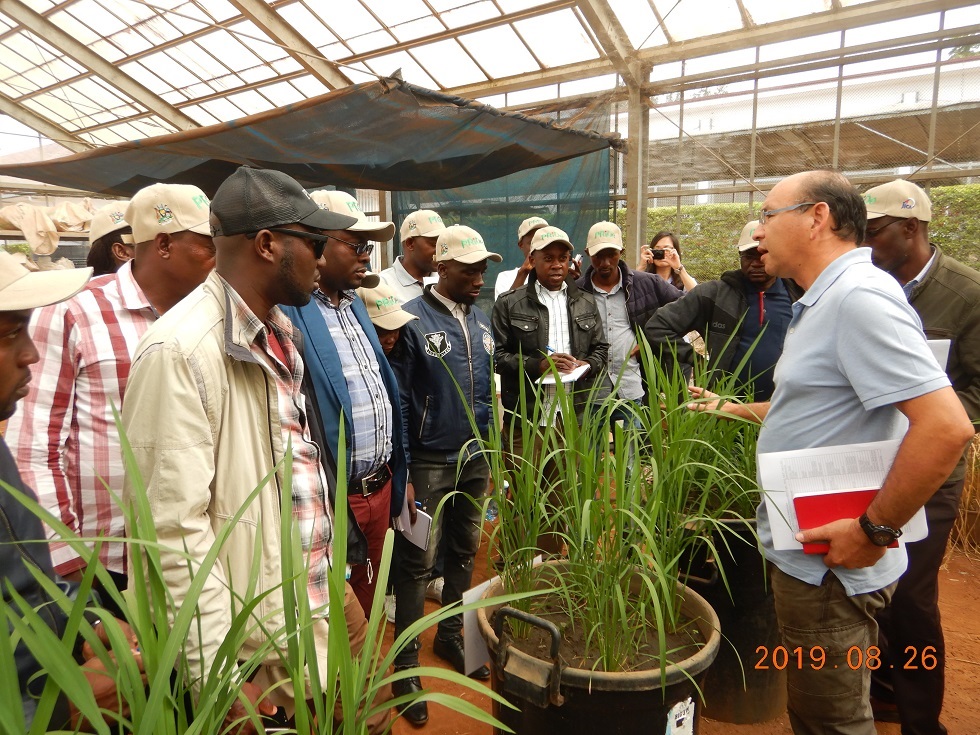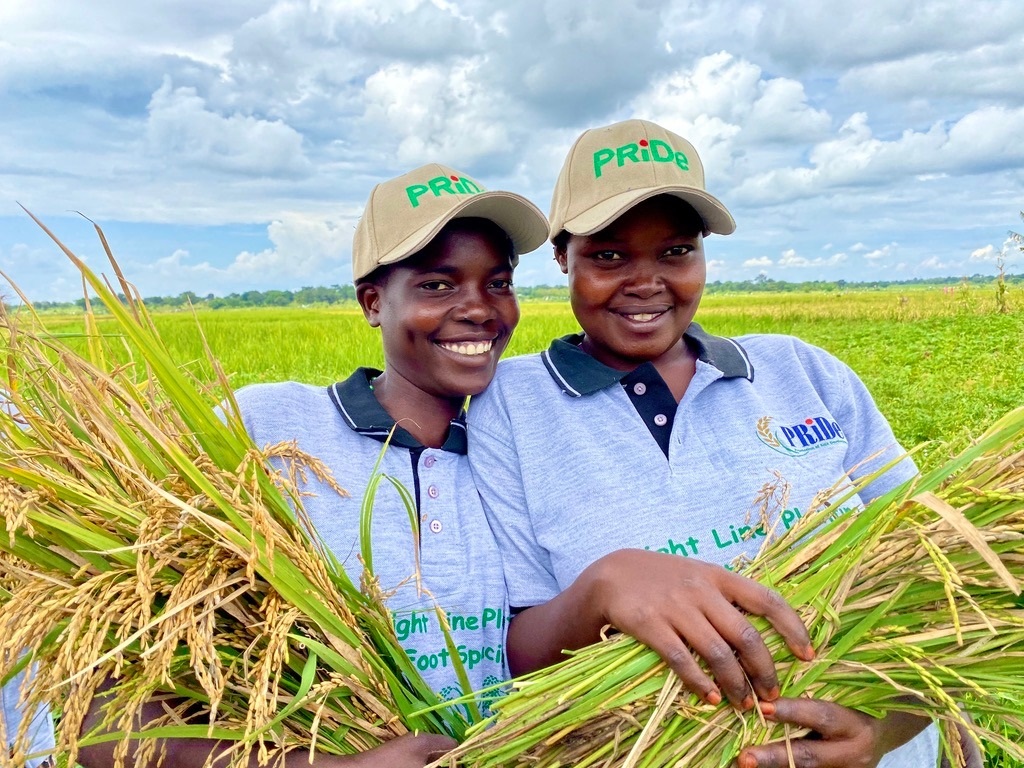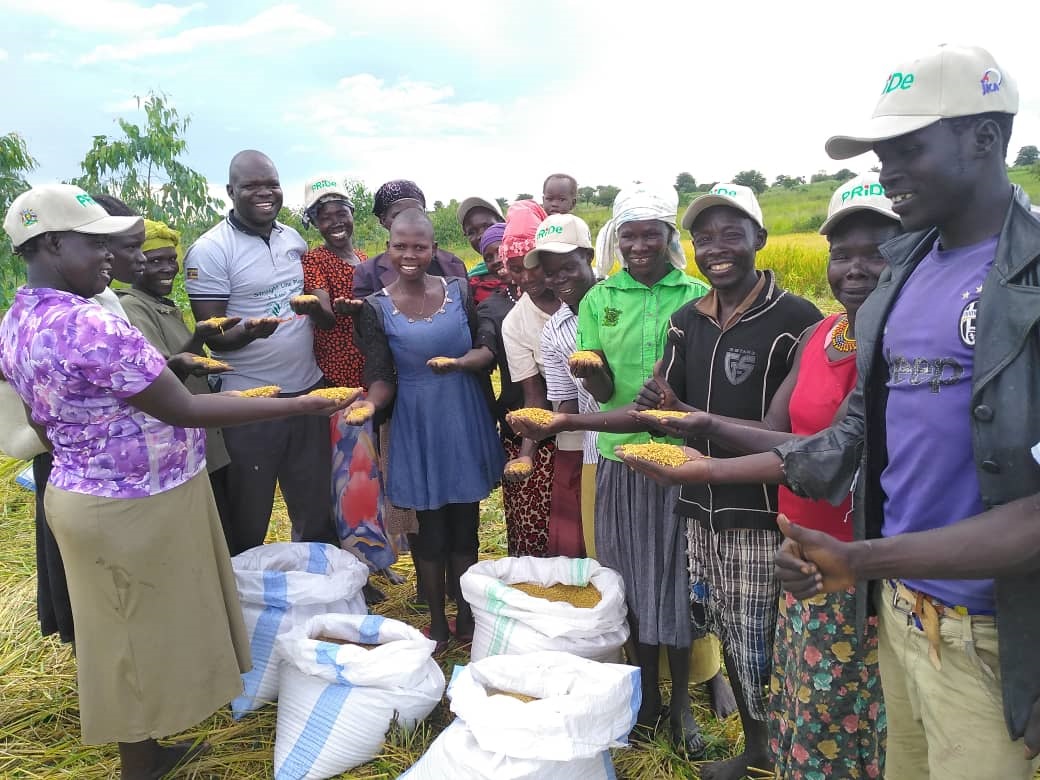The ATAAS Project
In 2010, the ATAAS project was developed as an investment in maintaining and raising the level of farmer productivity and household income through the development and adoption of modern farming technologies, techniques and strengthening market linkages. The project had key activities along the research-extension-farmer-market value chain continuum under five components: (1) Developing Agricultural Technologies and Strengthening the National Agricultural Research System (NARS); (2) Enhancing Partnerships between Agricultural Research, Advisory Services and other Stakeholders; (3) Strengthening the National Agricultural Advisory Services (NAADS); (4) Supporting Agribusiness Services and Market Linkages; and (5) Program Management and Coordination.
During the period 2011 to 2014 ATAAS supported various national agricultural research and extension programmes. It also supported the establishment and strengthening of research-extension-farmer and other value chain stakeholder linkages at the Zonal Agricultural Research and Development Institutes (ZARDIs), to improve linkages between farmers, their advisors and the research system. The nine (9) Research-Extension liaison units (one per ZARDI) were set-up to consolidate and better respond to farmers/stakeholder demand for improved technologies and to undertake research to adapt emerging technologies to local environments and farmer needs.
Further, they were equipped to carry out research and demonstrations on farmers’ fields, and to work closely with farmers and other priority value chain stakeholders in research priority setting, activity programing and results analysis. For this reason, an important level of demand-driven planning and participatory technology generation and dissemination were integrated into the Research and Development (R&D) system.
While ATAAS was being implemented, the Government of Uganda (GoU) also began to invest in the distribution of free inputs to farmers, mainly through NAADS. In view of the above, the World Bank (WB) and GoU restructured ATAAS, including restructuring NAADS and implementing a new extension system under the coordination of MAAIF. This was to help move the Ugandan agricultural sector forward constructively from the situation then, due to lack of human resources at field level. The re-structured ATAAS has continued to give support in developing NARO and the ZARDIs, as well as providing for some temporary stop-gap measures to link ZARDIs with as many farm communities as possible, while using technical support capacities available at district level. ATAAS also provided support to MAAIF to formulate the National Agricultural Policy (NAP) and a new Extension Strategy, including its dissemination and implementation arrangements.
In the absence of a functional national extension system, only a limited number of farmers can be reached within the project lifetime. Hence the restructured project makes provision for technology transfer through strengthened support to technology up-scaling and the increased use of information communication Technology (ICT) for outreach to farmers. It also has provision for supporting MAAIF to develop strategic and operational plans for the new extension program.
Agricultural Technology and Agribusiness Advisory Services (ATAAS) Project has four components. Identification of agricultural technologies and strengthening of the National Agricultural Research System (NARS), Component 1, is the primary responsibility of the National Agricultural Research Organisation (NARO). MAAIF and NARO jointly and collaboratively implement Component 2, which is Enhancing Partnerships between Agricultural Research, Extension and other Stakeholders. Component 3, Strengthening the Agricultural Support Services is a primary responsibility of the Ministry of Agriculture, Animal Industry and Fisheries (MAAIF), specifically under the Directorate of Agricultural Extension Service (DAES). While Component 4, Program management and M&E is as well a joint responsibility of NARO Secretariat (NAROSEC) and MAAIF Implementation Support Team (IST). All the other components changed during the restructuring except for component one (1) under NARO.
The project has registered performance progress as follows:
Under component 1, the research emphasis has been on genetic improvement, pests and diseases management, improved crop management and post-harvest management. For the reporting period, 23 technologies were generated, and eight (8) candidate varieties of finger millet (6) and groundnuts (2) submitted for release. Research on FAW has identified potential resistant varieties. In livestock, two (2) anti-tick vaccine molecules have been confirmed to effectively control blue ear ticks (Boophilus decoloratus) and are efficacious.
Research on non-strategic priorities addressed through the Competitive Grant Scheme (CGS) has progressed well. Over the last three years (2014 – 2017), ninety (90) projects have been approved for funding under the CGS project. Forty-one (41) projects are running under cohort III, and forty-nine (49) under cohort IV. A total sum of UGX 23 billion was budgeted to run these projects and UGX 19.5 billion (84.8%) has so far been disbursed. A sum of UGX 308.5 million was added as supplementary funding. Ten of the commercialisation projects have generated key tangible products that are ready for dissemination.
On institutional strengthening of NARO and other Agricultural Research Service Providers (ARSP), progress has been in areas of human capacity strengthening, civil works, and acquisition of specialized equipment and transport facilities. Thirty-one (31) scientists were supported to undergo PhD training, and so far seven have completed and graduated; one defended and awaits graduation, three have submitted their theses for defence, 15 are at different stages of writing theses while four are at proposal write up and one dropped. Eight (8) scientists are supported to undertake Master of Science training. Of these, six (6) have completed and two (2) are yet to defend their theses. Additionally, 65 scientists have been trained in short term and performance enhancement skills.
Under civil works, various contractors have concluded the construction and rehabilitation of 19 units, comprising of office buildings, conference centres and laboratories. Construction of a milking parlour is yet to commence, seeking World Bank clearance. On the other hand, the construction of the cattle shed is at 90% completion.
Promotion and dissemination activities including technology upscaling, establishment of adaptive trials, demonstrations seed multiplication and trainings, among others have been conducted under component 2. NARO established over 250 acres of seed/planting materials multiplication fields for different commodities, including food crops and pasture. Relatedly, the amount of seed, planting and stocking materials harvested and processed for distribution to farmers included 20 MT of Rice, 30 MT of Beans, 40 MT of Maize, seven (7) tonnes of silage and 1,000 bags of NASE 14 and NAROCAS1 cassava cuttings, among others.
Under the joint planning, priority setting and demand articulation, the staff trained as trainers during the previous reporting period have now received funding to facilitate the cascading of the training to lower levels – sub counties.
Under the subcomponent on Sustainable Land Management (SLM), in MAAIF, significant area and distance have been covered with demonstrations and upscaling of SLM technologies. In the reporting period, 1,347 hectares (ha) of terraces, 2,754 kilometres (km) of contour bunds, 2,000 km of grass bunds, 2,150 ha of agroforestry have been established, 191 ha of degraded watersheds reclaimed, 956 ha of woodlots, 584 ha of conservation agriculture and 14 ha of small scale irrigation. In addition, 49 water harvesting micro schemes were established. In NARO, six (6) out of the 17 soil maps have been updated from a scale of 1: 250,000 to a scale 1: 50,000.
Under Component 3, Farmer Group Needs Assessment and development of a register of all Farmer Groups in the Country along with the requisite training materials for Farmer Institutional Development has been undertake. Five hundred and eighty six (586) different categories of staff and district leaders, which include Farmer leaders, Secretaries for Production and DPMOs have been trained in various extension delivery enhancement skills of Mind-Set Change, Control of Ticks and Tick-borne disease, Dry season feeding, Infectious/ zoonotic diseases + avian influenza, Agribusiness development, Agricultural statistics, Appropriate Post-harvest Handling techniques, Agro-chemicals Handling and fertiliser optimisation, Fruit value chain and production techniques and seed selection, nursery management and seedling handling.
The Directorate Agricultural Extension Services in fulfilling its mandate, developed National Agricultural Extension Policy (NAEP) 2016. To operationalize the Strategy, the DAES is in the process of developing the guidelines and standards for the regulation and quality assurance of the Agricultural extension services, already the TPM has approved. In addition, a National Agricultural Knowledge Management and Communication Strategy has been developed and approved by TPM in June 2017.
So far up to 11 Memoranda of Understanding (MoUs) with various institutions to support Extension Service Delivery have been entered into. A draft extension Manual has been developed with the help of a consultant and it is under review by the MAAIF technical team.
Under Component 4 on program management, coordination and monitoring and evaluation (M&E), the IST conducted several Financial Management visits to the implementing entities in the zones and districts, while procurement undertook several evaluation exercises. In subcomponent 4.3 on joint M&E, the revised ATAAS Project Implementation Manual (PIM) and M&E Manual were completed. In addition, the Process Evaluation was finalised, enabling the update of the outcome indicators of the Results Framework.
The accumulated financial performance stands at 99% disbursements from the Bank, of which 76% has been expended. Given the No Cost Extension granted by the Bank, MAAIF and NARO are confident of expending the remaining 24%, much of it as payments for procured goods and services, in the remaining period.
At this level of financial performance, the project has as well made tremendous physical performance against the project indicators given the recent process evaluation exercise commissioned by MAAIF. Positive changes in yields have been achieved, with an increase of more than 10 percent over the benchmark. Specifically increases in key project commodities indicate that maize yields have increased over the baseline by 22.4%, cassava by 41.7%, rice increased by 41.4%, milk per cow was by 57.7% and only beans have a minimum increase of 4%.
Increase in commodity yields have met the end of project targets except bean yields that is at approximated 6% below the project targets but this too, is very likely to meet the target at the end of the project. However, where low yields have been recorded in some areas and attributed to factors like prolonged drought/floods, lack of capacity building, late delivery of inputs past rain seasons and poor quality of planting materials/breeds due to suppliers mixing research technologies with poor local ones.
In terms of incomes, the project beneficiaries have realized positive changes in attaining household incomes and in most cases surpassed the project target. The project target was to increase household incomes by 20% over the period. Incomes of participating households increased by 141.7% over the baseline from UGX 1,357,900 in 2013 to UGX 3,380,632 in 2016, surpassing the target of UGX 2,229,731 by 34%. The gender difference income growth has as well been narrowing by 0.3% between men and women in the years 2013 and 2016. Men’s income was at 7.7% (UGX 1,693,184) in 2013 higher than women but reduced to 7.4% UGX (1,687,448) higher in 2016.
Under the GEO, the outputs are to be achieved through up-scaling of the following technologies: i) Terraces; ii) Contour bunds; iii) Grass bunds; iv) Conservation agriculture; v) Agro-forestry; vi) Woodlots; vii) Agronomic/vegetative SLM practices (mulching; intercropping; rotations); integrated nutrient management, grassland improvement; and viii) Rehabilitation/reclamation of degraded watershed.
Up scaling of three technologies of Conservation agriculture, Terraces and Rehabilitation/reclamation of degraded watershed have registered a performance of over 200%. Up scaling of other technologies of Contour bunds, Grass bunds, Agro-forestry and Agronomic/vegetative SLM practices (mulching; intercropping; rotations) are at over 50% on average. The other three technologies of Woodlots, Water harvesting (Micro-schemes) and Small scale irrigation (ha) are way below 50% performance. The focus in the remaining project period is to support upscale these three technologies.
Other projects
- National Oil Palm Project Uganda
- NUFLIP PHASE 1
- The UMFSNP project
- Banana Livelihood Diversification project
- Uganda-China Cooperation
- The ACDP project
- The VODP2
- The ENRP project
- The ATAAS project
- The PISD project
- The RPLRP project
- The MOBIP project
- The Goat Export Project
The Uganda Multi-sectoral Food Security and Nutrition Project (UMFSNP) is implemented, over a period of five years, by the Government of Uganda (GoU) through the Ministry of Agriculture, Animal Industry, and Fisheries (MAAIF) working in a multi-sectoral collaboration with the Ministry of Health (MoH) and the Ministry of Education, Science Technology and Sports (MoESTS)
This project helps to support vulnerable communities in Western Uganda to better adapt to the effects of climate change (CC) through banana value addition activities, to provide greater opportunities for income generation, poverty reduction and food security
The Government of the Republic of Uganda and the Government of the People’s Republic of China have had a cordial relationship for a long time. China has made significant contributions to Uganda’s Agricultural sector development including provision of project aid to Uganda in form of interest-free loans and grants. Notable ones include the Kibimba and Doho rice schemes, Wakawaka Fish landing site, Kajjansi Aquaculture Training Centre, Hydropower Stations and Road Construction. Trade has included leather, coffee, fish and food products among others.
The Ministry of Agriculture, Animal Industry and Fisheries (MAAIF), with support from the World Bank is implementing the Agriculture Cluster Development Project (ACDP). The project arose from the need to implement the Ministry’s comprehensive plan to operationalize the Agriculture Sector Development Strategy and Investment Plan 2011/12 – 2014/15 (now Agriculture Sector Strategic Plan 2015/16 – 2019/20) and in line with the Uganda National Development Plan.
Uganda imports 60-70% of its edible and soap needs; Population growth and rising incomes continue to fuel an annual growth rate of 9% in domestic and regional demand for vegetable oil and its by-products. VODP 2 is Uganda’s strategic effort and increase domestic vegetable oil production, address rural poverty by involving smallholder farmers in oil crops production and improve the health of the population through increased vegetable oil intake.
The project is expected to increase production and productivity, mainly of small holder rice farmers, by focusing on those factors that currently limit production which include;
In 2010, the ATAAS project was developed as an investment in maintaining and raising the level of farmer productivity and household income through the development and adoption of modern farming technologies, techniques and strengthening market linkages. The project had key activities along the research-extension-farmer-market value chain continuum under five components: (1) Developing Agricultural Technologies and Strengthening the National Agricultural Research System (NARS); (2) Enhancing Partnerships between Agricultural Research, Advisory Services and other Stakeholders; (3) Strengthening the National Agricultural Advisory Services (NAADS); (4) Supporting Agribusiness Services and Market Linkages; and (5) Program Management and Coordination.
The Ministry of Agriculture, Animal Industry, and Fisheries (MAAIF) and Japan International Cooperation Agency (JICA) agreed to execute a study for Irrigation Scheme Development referred to as The Project on Irrigation Scheme Development in Central and Eastern Uganda (PISD) through technical cooperation.
The focus was on establishment of medium and large scale irrigation scheme in Uganda targeting farmers cultivating mainly rice in lowland areas with season flooding and unreliable agricultural water source(s). The Study has was entrusted by JICA to the JICA Study Team consists of a consultant from Japan in collaboration with counterpart staffs from MAAIF and MWE. A total of 10 candidate sites districts were studied for irrigation development potential in the districts of Butambala, Buikwe, Kween, Sironko, Bukedea, Bulambuli, Mbale, Butaleja, Budaka and Soroti..
The Regional Pastoral Livelihoods Resilience Project (RPLRP) is a regional project financed by a USD 40 Million loan got by GOU from the World Bank and implemented by three IGAD member states: Uganda, Kenya and Ethiopia.
The RPLRP was prepared within the framework of the IGAD Drought Disaster Resilience and Sustainability Initiative (IDDRSI) and aligned with the Regional Programming Paper (RPP) and Country Programming Paper (CPPs).
Uganda Vision 20140 is a key strategy document for the government of Uganda (GOU) and aims to make Uganda a middle-income country by 2040. The National Development Plan II (NDP2) mentions the development of the livestock sector as one of these strategies, and in particular Uganda’s ability to produce some of the best beef in Africa.
Project Objectives
“To enhance the contribution of the goat industry to farmers’ income and welfare.”
Specific objectives
Avail improved indigenous and exotic (Savannah) goat germplasm to farmers in the project area which will serve as a springboard for establishing a pilot goat export zone in the country
To establish open nucleus breeding herds coupled with systematic cross breeding programme for generating meat goat types for fattening and
Improve the goat management systems and create sustainable supplies of quality goats for internal and export markets.

